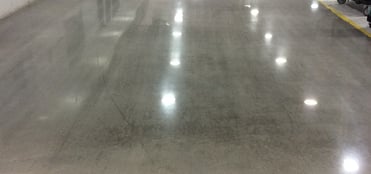 Concrete polishing is an efficient and economical way to beautify and strengthen a concrete floor. Not only does the attractive shine improve the floor’s aesthetics, but the mechanical process of grinding and smoothing the floor actually increases the concrete’s strength.
Concrete polishing is an efficient and economical way to beautify and strengthen a concrete floor. Not only does the attractive shine improve the floor’s aesthetics, but the mechanical process of grinding and smoothing the floor actually increases the concrete’s strength.
The Dry Polish Method
For the dry polish method, the surface of the concrete is ground using commercial-scale polishing machines. Each stage of the process requires a different abrasive polishing disk, often incorporating diamond grit, with coarser textures for earlier stages and finer ones to get the final shine.
Much of the dust is vacuumed up as it is ground, but some dust does get into the air. The crews at CPC Floor Coatings do use water between different stages of dry polishing in order to minimize dust, though the polishing process itself is dry.
 Advantages of dry method polishing:
Advantages of dry method polishing:
- Higher shine
- Does more to the slab in terms of hardening and condensing
- Can be done in both open areas and small nooks, thanks to hand machines
Disadvantages of dry concrete polishing:
- Longer downtime
- Generally a higher cost than wet
The Wet Polish Method
In the wet polish method, water is applied to the concrete so that the dust is captured in a slurry that stays out of the air. The polishing disks for this method have the same grit sizes, but the final product has a low luster rather than a glassy shine.
 Advantages of wet method polishing:
Advantages of wet method polishing:
- Shorter downtime
- Less expensive
- Can use propane-fueled machines, which are better for the environment
- 100% dust-free process to avoid any dust contamination
Disadvantages of wet concrete polishing:
- Can’t achieve the same high-gloss shine
- Can’t use hand machines, so limited to large, open-access areas only
- While the dust stays out of the air, the wet slurry on the surface is more time-consuming to clean
Which is right for my facility?
Food and beverage facilities are often required by law to use a dust-free method of polishing, so the wet polish method is a must. Companies who want to impress customers with a high-gloss floor will have better results with the dry method.
In other cases the choice between wet and dry depends on the physics of your location, your timetable, and the level of performance you expect from your floor. You’ll want to work with a knowledgeable contractor in the concrete polishing field to determine the best course of action for your facility.
If you’re in the Southeast and are seriously considering concrete polishing, one of the flooring experts at CPC would be glad to walk you through your options. Give us a call at (864) 855-0600 or contact us online.
If you’d like to learn more about concrete polishing in general, click the banner below to reach our concrete polishing information hub.

